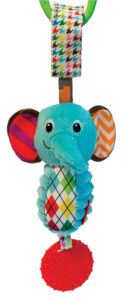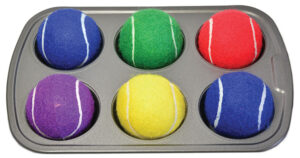Fine motor development, Gross motor development
An infant participates in open-ended play with a toy that includes opportunities to reach for the toy.



Be Prepared: Attach a chain of connecting links to a small toy that you anticipate will be of strong interest to the infant.
 [Place an infant on his/her back on a firm surface, such as a carpet or activity mat. Kneel or sit at the infant’s feet. Begin by engaging the infant in an interaction with you by talking, smiling, and making eye contact. Example: “Hi Niko. Are you ready to play?” Pause for the infant to react non-verbally or with a sound.
[Place an infant on his/her back on a firm surface, such as a carpet or activity mat. Kneel or sit at the infant’s feet. Begin by engaging the infant in an interaction with you by talking, smiling, and making eye contact. Example: “Hi Niko. Are you ready to play?” Pause for the infant to react non-verbally or with a sound.
Describe the infant’s reactions to your voice. Example: “Niko, you are smiling and kicking your feet. Your eyes got wide when I said your name. I think you are ready to play!”]
[Hold the connecting links with the toy suspended over the infant’s chest within his/her reach. “Maybe you would like to move our toy or hold our toy.”
Encourage the infant to reach for the toy. Be sure to hold the object at the midline over the center of the infant’s chest. Offer encouraging words if the infant tries to reach for the toy. Example: “You are reaching for our toy, Niko!”]
 Would you like to hold our toy?
Would you like to hold our toy?
[The infant will likely adjust his/her reaching as the toy naturally sways. Swinging the connecting links is not advised because it prevents the infant from successfully reaching the toy. Leave pauses in your speech for the infant to respond to you or to focus fully on the toy.]
[Remove the toy from the links so the infant can explore the toy by touching and moving it on his/her own. The infant may also bring the toy to his/her mouth for more exploration. After several minutes, change the infant’s position and bring the activity to an end.]
[Describe the infant’s specific actions and responses to the activity. Example: “Niko, you really liked our toy swinging over your chest. You liked kicking your feet and swiping at the toy with your hands.”]
Watch carefully the infant’s level of interest in the activity. Lack of attention may indicate a need to increase or decrease the challenge. Keep in mind that swinging the links does not help the infant reach for the toy. Lack of attention also might indicate the toy is not of interest to the infant. You may wish to try a different toy.
An infant who has learned to roll over may change positions after he/she has a hold on the toy.
If an infant becomes overstimulated during the activity, talk softly to him/her and place your hand on his/her leg, tummy, or upper arm. Some infants may need to be held in order to regain a calm state.
Extra support
Enrichment
Fine motor development, Gross motor development
An infant practices extending his/her arms to reach and grasp different objects.



 Gather several small blocks. Invite an infant who is learning to sit independently to sit on your lap facing a low table. Sit close to the table and hold your hands around the infant’s torso to provide support. You may also wrap one arm around the infant’s middle for support.
Gather several small blocks. Invite an infant who is learning to sit independently to sit on your lap facing a low table. Sit close to the table and hold your hands around the infant’s torso to provide support. You may also wrap one arm around the infant’s middle for support.
Place one block close to the infant. Encourage the infant to reach his/her arms out to touch the block. Next, place a second block close to the infant. Watch the infant’s reaction to seeing two blocks. An infant may drop the first block to reach the second, or hold one block in each hand.
Pay attention to how far the infant can extend his/her arm and hand. These actions are central to reaching. Place items within challenging but achievable reach. If an infant seems agreeable, briefly remove one block and then put it back to provide another reaching opportunity and to support the infant’s attention to the block. Be aware of signs of fatigue and bring the activity to a close if the infant appears tired or stressed.
At about six months, many infants develop the upper body strength needed to lean forward and return to an upright position to examine a toy. Muscles supporting the head and back are engaged when the infant leans forward and/or manipulates the blocks. Returning to an upright and balanced position may be a challenge for some infants. If sitting at a low table is not comfortable for the infant, move the activity to the floor. Sit behind the infant to give extra support for sitting if needed. Some infants may enjoy leaning forward and changing to a prone position to explore the toy.
Include small animal figures to strengthen interest in reaching. Depending upon your knowledge of the infant, consider adding playful sounds to your interaction, such as saying “Ta-da!” when the infant grasps a toy. Some infants may enjoy the feeling of tapping the blocks on the tabletop.
Extra support
Enrichment
Fine motor development, Gross motor development
An infant practices reaching and grasping by moving pop beads from one bowl to another bowl.



Sit on the floor next to an infant who sits independently. Place several pop beads into one bowl. Ask the infant if he/she would like to join you in playing with the beads. Begin to transfer pop beads from one bowl to the other. Encourage the infant to move the pop beads from one bowl to another. Describe the infant’s actions. Example: “You are using your arm to reach for a bead. You are using your hand to pick up a bead.”
You may wish to use separate bowls, one set for the infant and one set for you. This arrangement supports parallel activity with the beads. Another option is to use two bowls only, with both you and the infant moving beads from one bowl to another. This decision may rest on whether you expect to continue moving beads after the infant engages in transferring beads from one bowl to another.
Other small toys may be used instead of pop beads.
This activity builds on infants’ inherent interest in moving objects from one place to another place. It is rarely a boring activity in the very early years. Look for opportunities to emphasize how the infant is using his arm to reach and his hand to pick up a bead.
An infant who can stand or walk may enjoy the activity on a low surface. Be sure to place the materials at a suitable height, so the activity remains focused on arm and hand movement.
Note the Enrichment tip about promoting use of a different hand. Imagine the infant’s midline as an invisible line marking left and right sides of the body. Encouraging an infant to reach to one side with the opposite hand while maintaining balance supports the development of body coordination, strength, and balance.
Extra support
Enrichment
 Materials Needed: infant gym, sock rattle, pop beads, bowl, muffin pans, tennis balls
Materials Needed: infant gym, sock rattle, pop beads, bowl, muffin pans, tennis balls
Playing on the floor helps infants develop strength and coordination. For a few minutes, a nonmobile infant may enjoy swiping at toys attached to an infant gym. Infants generally enjoy kicking their feet. Placing a sock rattle on one or both of an infant’s feet also promotes kicking. For infants who can sit independently, place loose toys, such as pop beads, in a bowl on the floor. Crawling to the bowl to dump the toys out will be enjoyable for some infants. Infants will move from hands and knees position to a sitting position in order to tip the container or remove the toys one by one. On another day, place muffin pans with tennis balls in a location where crawling infants will discover them.
Infants who have learned to pull up to stand will enjoy manipulating play materials on a low surface. Infants often delight in dropping toys from a low surface to the floor. Return the play materials to the low surface and encourage the infants to try again. Infants who can walk will enjoy discovering pop beads and muffin pans in the sensory table. Some infants may place pop beads into the muffin pan. At this age, infants are not expected to put pop beads together.
Offer toddlers and preschool-age children opportunities that incorporate moving their legs and arms at the same time. Example: play a game of make-believe with children, such as pretending to be birds. Encourage children to flap their “wings” as they move from place to place. When playing indoors, the children might pretend to fly from an imaginary branch to a nest. Structure the pretend game by making up and singing a song about movements or destinations. Encourage children to listen to the song to learn what to do. Examples: “see the birds flying high,” “see the birds fly to their nest . . . it is time to rest.”